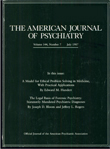Brain Elimination Half-Life of Fluvoxamine Measured by 19F Magnetic Resonance Spectroscopy
Abstract
OBJECTIVE: This study used fluorine-19 magnetic resonance spectroscopy (19F MRS) to characterize the elimination of fluvoxamine from the human brain after abrupt drug discontinuation. The elimination half-lives of fluvoxamine in brain and plasma were determined to assess their interdependence and the relationship of brain half-life to the clinical practice of drug holidays and reports of acute withdrawal symptoms. METHOD: Six subjects completing clinical treatment with fluvoxamine were enrolled in the study. Spectroscopic quantification of whole brain fluvoxamine concentrations and chromatographic determination of plasma fluvoxamine levels were performed serially for up to 10 days after drug withdrawal. Psychiatric evaluation to assess withdrawal symptoms was also done at each scanning session. RESULTS: Elimination of fluvoxamine in the brain and plasma was optimally described by first-order kinetics; the mean elimination half-lives were 58 hours and 26 hours, respectively. The mean ratio of fluvoxamine brain elimination half-life to plasma half-life was 2.4. Three of the six subjects experienced mild to moderate withdrawal symptoms between the third and fifth days of the study, which corresponded to between one and two brain half-lives of fluvoxamine. CONCLUSIONS: The brain elimination half-life for fluorinated psychotropic compounds can be measured noninvasively by 19F MRS. The elimination half-life of fluvoxamine was found to be substantially longer for the brain than for plasma. The time course of withdrawal symptom onset and the rationale for drug holidays with fluvoxamine appear to be well explained by the brain elimination half-life.



